2015 NISSAN ROGUE SELECT tires
[x] Cancel search: tiresPage 288 of 322
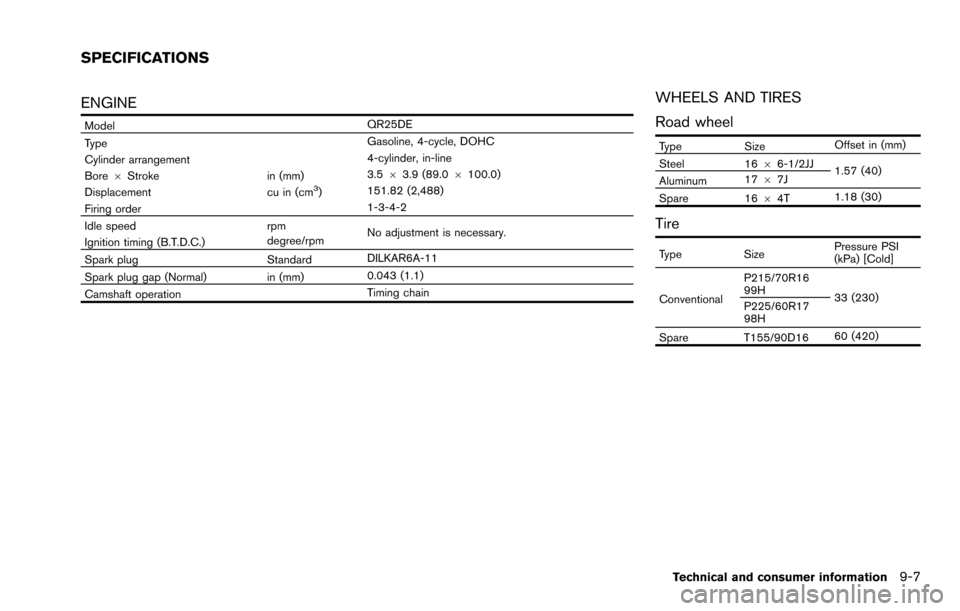
ENGINE
ModelQR25DE
Type Gasoline, 4-cycle, DOHC
Cylinder arrangement 4-cylinder, in-line
Bore 6Stroke in (mm)3.5
63.9 (89.0 6100.0)
Displacement cu in (cm
3)151.82 (2,488)
Firing order 1-3-4-2
Idle speed rpm
No adjustment is necessary.
Ignition timing (B.T.D.C.) degree/rpm
Spark plug StandardDILKAR6A-11
Spark plug gap (Normal) in (mm)0.043 (1.1)
Camshaft operation Timing chain
WHEELS AND TIRES
Road wheel
Type
Size Offset in (mm)
Steel 1666-1/2JJ
1.57 (40)
Aluminum 17
67J
Spare 16 64T 1.18 (30)
Tire
Type
Size Pressure PSI
(kPa) [Cold]
Conventional P215/70R16
99H
33 (230)
P225/60R17
98H
Spare T155/90D16 60 (420)
Technical and consumer information9-7
SPECIFICATIONS
Page 295 of 322
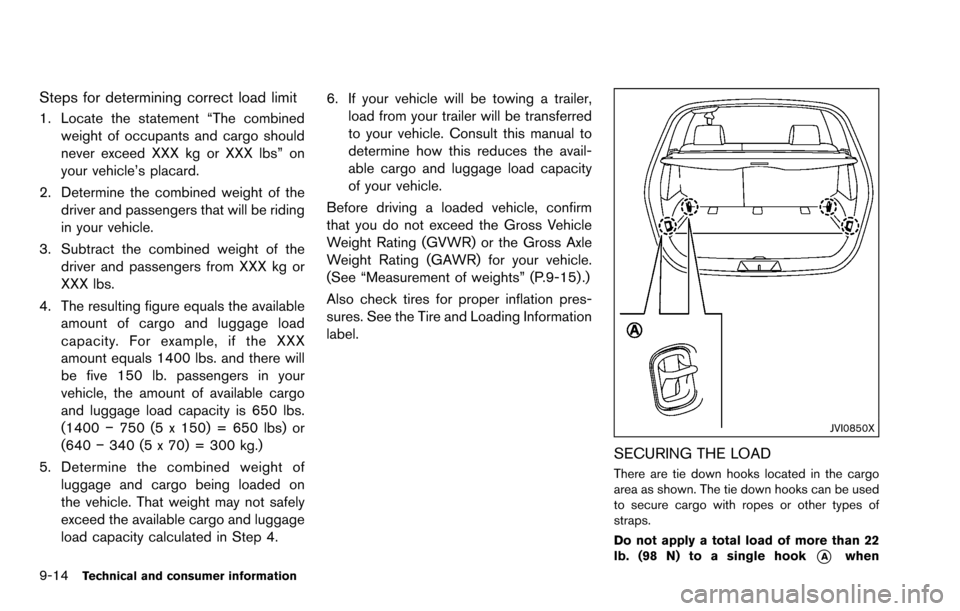
9-14Technical and consumer information
Steps for determining correct load limit
1. Locate the statement “The combinedweight of occupants and cargo should
never exceed XXX kg or XXX lbs” on
your vehicle’s placard.
2. Determine the combined weight of the driver and passengers that will be riding
in your vehicle.
3. Subtract the combined weight of the driver and passengers from XXX kg or
XXX lbs.
4. The resulting figure equals the available amount of cargo and luggage load
capacity. For example, if the XXX
amount equals 1400 lbs. and there will
be five 150 lb. passengers in your
vehicle, the amount of available cargo
and luggage load capacity is 650 lbs.
(1400 �í750 (5 x 150) = 650 lbs) or
(640 �í340 (5 x 70) = 300 kg.)
5. Determine the combined weight of luggage and cargo being loaded on
the vehicle. That weight may not safely
exceed the available cargo and luggage
load capacity calculated in Step 4. 6. If your vehicle will be towing a trailer,
load from your trailer will be transferred
to your vehicle. Consult this manual to
determine how this reduces the avail-
able cargo and luggage load capacity
of your vehicle.
Before driving a loaded vehicle, confirm
that you do not exceed the Gross Vehicle
Weight Rating (GVWR) or the Gross Axle
Weight Rating (GAWR) for your vehicle.
(See “Measurement of weights” (P.9-15) .)
Also check tires for proper inflation pres-
sures. See the Tire and Loading Information
label.
JVI0850X
SECURING THE LOAD
There are tie down hooks located in the cargo
area as shown. The tie down hooks can be used
to secure cargo with ropes or other types of
straps.
Do not apply a total load of more than 22
lb. (98 N) to a single hook
*Awhen
Page 302 of 322
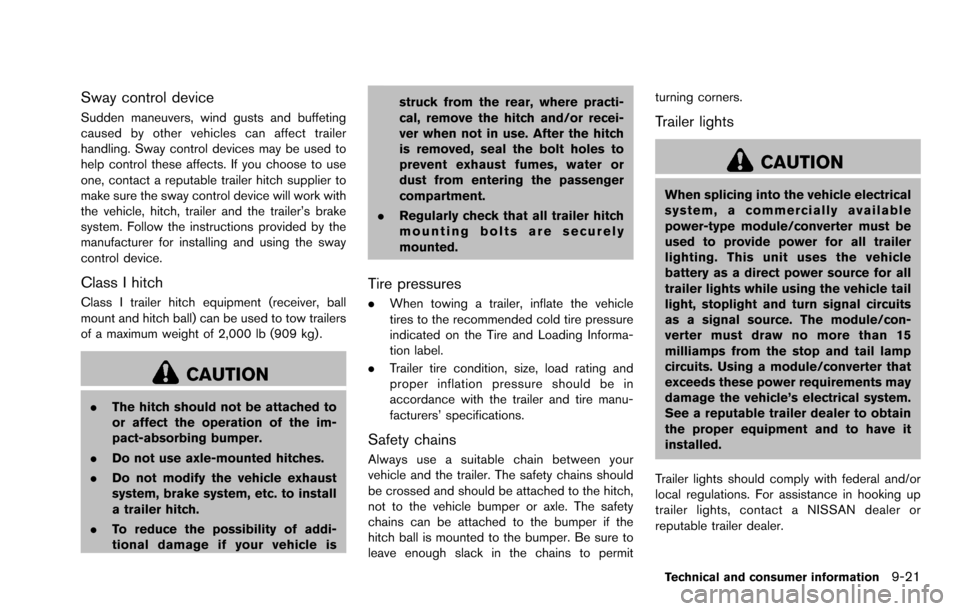
Sway control device
Sudden maneuvers, wind gusts and buffeting
caused by other vehicles can affect trailer
handling. Sway control devices may be used to
help control these affects. If you choose to use
one, contact a reputable trailer hitch supplier to
make sure the sway control device will work with
the vehicle, hitch, trailer and the trailer’s brake
system. Follow the instructions provided by the
manufacturer for installing and using the sway
control device.
Class I hitch
Class I trailer hitch equipment (receiver, ball
mount and hitch ball) can be used to tow trailers
of a maximum weight of 2,000 lb (909 kg) .
CAUTION
.The hitch should not be attached to
or affect the operation of the im-
pact-absorbing bumper.
. Do not use axle-mounted hitches.
. Do not modify the vehicle exhaust
system, brake system, etc. to install
a trailer hitch.
. To reduce the possibility of addi-
tional damage if your vehicle is struck from the rear, where practi-
cal, remove the hitch and/or recei-
ver when not in use. After the hitch
is removed, seal the bolt holes to
prevent exhaust fumes, water or
dust from entering the passenger
compartment.
. Regularly check that all trailer hitch
mounting bolts are securely
mounted.
Tire pressures
.When towing a trailer, inflate the vehicle
tires to the recommended cold tire pressure
indicated on the Tire and Loading Informa-
tion label.
. Trailer tire condition, size, load rating and
proper inflation pressure should be in
accordance with the trailer and tire manu-
facturers’ specifications.
Safety chains
Always use a suitable chain between your
vehicle and the trailer. The safety chains should
be crossed and should be attached to the hitch,
not to the vehicle bumper or axle. The safety
chains can be attached to the bumper if the
hitch ball is mounted to the bumper. Be sure to
leave enough slack in the chains to permit turning corners.
Trailer lights
CAUTION
When splicing into the vehicle electrical
system, a commercially available
power-type module/converter must be
used to provide power for all trailer
lighting. This unit uses the vehicle
battery as a direct power source for all
trailer lights while using the vehicle tail
light, stoplight and turn signal circuits
as a signal source. The module/con-
verter must draw no more than 15
milliamps from the stop and tail lamp
circuits. Using a module/converter that
exceeds these power requirements may
damage the vehicle’s electrical system.
See a reputable trailer dealer to obtain
the proper equipment and to have it
installed.
Trailer lights should comply with federal and/or
local regulations. For assistance in hooking up
trailer lights, contact a NISSAN dealer or
reputable trailer dealer.
Technical and consumer information9-21
Page 306 of 322
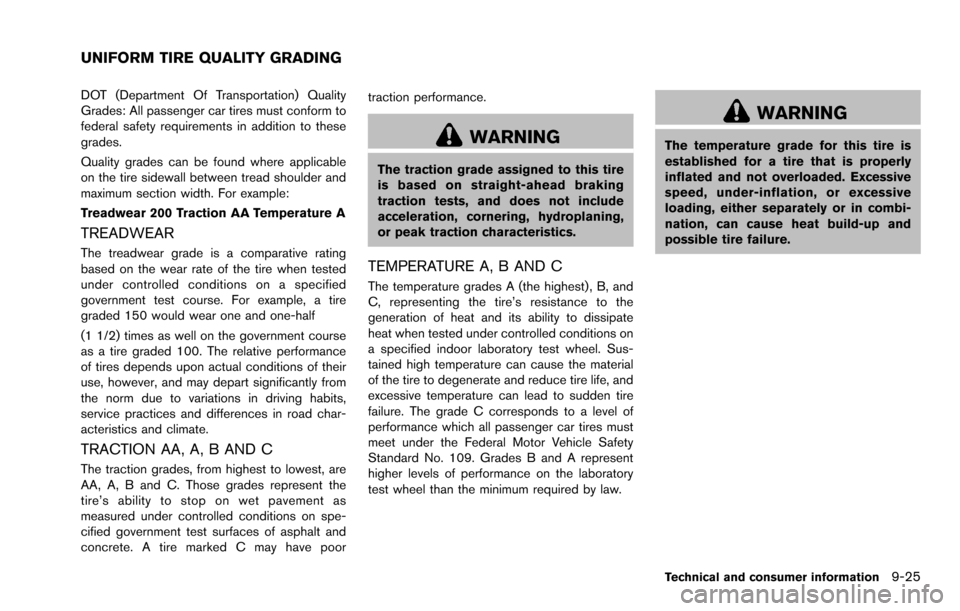
DOT (Department Of Transportation) Quality
Grades: All passenger car tires must conform to
federal safety requirements in addition to these
grades.
Quality grades can be found where applicable
on the tire sidewall between tread shoulder and
maximum section width. For example:
Treadwear 200 Traction AA Temperature A
TREADWEAR
The treadwear grade is a comparative rating
based on the wear rate of the tire when tested
under controlled conditions on a specified
government test course. For example, a tire
graded 150 would wear one and one-half
(1 1/2) times as well on the government course
as a tire graded 100. The relative performance
of tires depends upon actual conditions of their
use, however, and may depart significantly from
the norm due to variations in driving habits,
service practices and differences in road char-
acteristics and climate.
TRACTION AA, A, B AND C
The traction grades, from highest to lowest, are
AA, A, B and C. Those grades represent the
tire’s ability to stop on wet pavement as
measured under controlled conditions on spe-
cified government test surfaces of asphalt and
concrete. A tire marked C may have poortraction performance.
WARNING
The traction grade assigned to this tire
is based on straight-ahead braking
traction tests, and does not include
acceleration, cornering, hydroplaning,
or peak traction characteristics.
TEMPERATURE A, B AND C
The temperature grades A (the highest) , B, and
C, representing the tire’s resistance to the
generation of heat and its ability to dissipate
heat when tested under controlled conditions on
a specified indoor laboratory test wheel. Sus-
tained high temperature can cause the material
of the tire to degenerate and reduce tire life, and
excessive temperature can lead to sudden tire
failure. The grade C corresponds to a level of
performance which all passenger car tires must
meet under the Federal Motor Vehicle Safety
Standard No. 109. Grades B and A represent
higher levels of performance on the laboratory
test wheel than the minimum required by law.
WARNING
The temperature grade for this tire is
established for a tire that is properly
inflated and not overloaded. Excessive
speed, under-inflation, or excessive
loading, either separately or in combi-
nation, can cause heat build-up and
possible tire failure.
Technical and consumer information9-25
UNIFORM TIRE QUALITY GRADING
Page 316 of 322
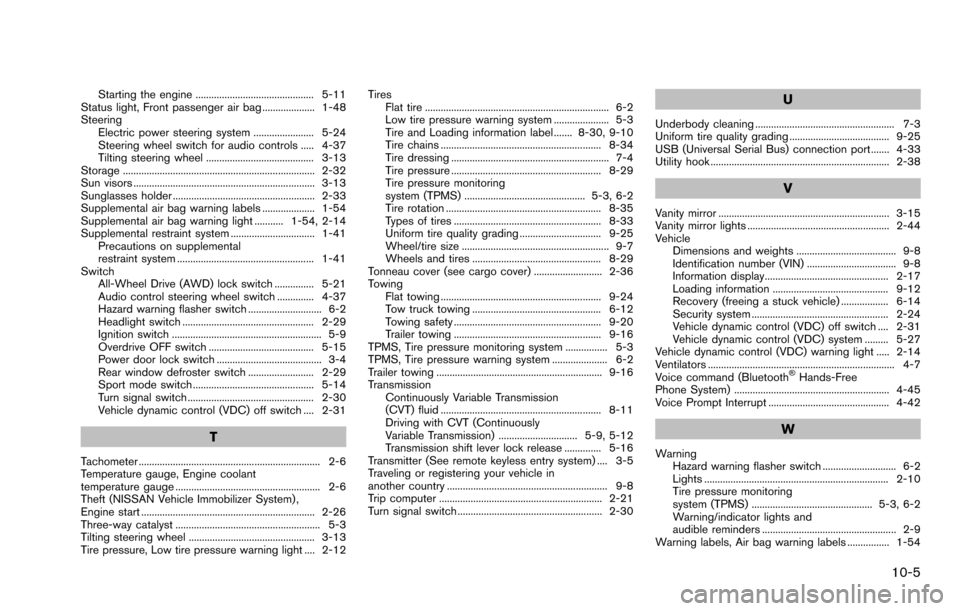
Starting the engine ............................................. 5-11
Status light, Front passenger air bag .................... 1-48
Steering Electric power steering system ....................... 5-24
Steering wheel switch for audio controls ..... 4-37
Tilting steering wheel ......................................... 3-13
Storage ......................................................................... 2-32
Sun visors ..................................................................... 3-13
Sunglasses holder ...................................................... 2-33
Supplemental air bag warning labels .................... 1-54
Supplemental air bag warning light ........... 1-54, 2-14
Supplemental restraint system ................................ 1-41 Precautions on supplemental
restraint system .................................................... 1-41
Switch All-Wheel Drive (AWD) lock switch ............... 5-21
Audio control steering wheel switch .............. 4-37
Hazard warning flasher switch ............................ 6-2
Headlight switch .................................................. 2-29
Ignition switch ......................................................... 5-9
Overdrive OFF switch ........................................ 5-15
Power door lock switch ........................................ 3-4
Rear window defroster switch ......................... 2-29
Sport mode switch .............................................. 5-14
Turn signal switch ................................................ 2-30
Vehicle dynamic control (VDC) off switch .... 2-31
T
Tachometer ..................................................................... 2-6
Temperature gauge, Engine coolant
temperature gauge ....................................................... 2-6
Theft (NISSAN Vehicle Immobilizer System) ,
Engine start .................................................................. 2-26
Three-way catalyst ....................................................... 5-3
Tilting steering wheel ................................................ 3-13
Tire pressure, Low tire pressure warning light .... 2-12 Tires
Flat tire ...................................................................... 6-2
Low tire pressure warning system ..................... 5-3
Tire and Loading information label ....... 8-30, 9-10
Tire chains ............................................................. 8-34
Tire dressing ............................................................ 7-4
Tire pressure ......................................................... 8-29
Tire pressure monitoring
system (TPMS) .............................................. 5-3, 6-2
Tire rotation ........................................................... 8-35
Types of tires ........................................................ 8-33
Uniform tire quality grading ............................... 9-25
Wheel/tire size ........................................................ 9-7
Wheels and tires ................................................. 8-29
Tonneau cover (see cargo cover) .......................... 2-36
Towing Flat towing ............................................................. 9-24
Tow truck towing ................................................. 6-12
Towing safety ........................................................ 9-20
Trailer towing ........................................................ 9-16
TPMS, Tire pressure monitoring system ................ 5-3
TPMS, Tire pressure warning system ..................... 6-2
Trailer towing ............................................................... 9-16
Transmission Continuously Variable Transmission
(CVT) fluid ............................................................. 8-11
Driving with CVT (Continuously
Variable Transmission) .............................. 5-9, 5-12
Transmission shift lever lock release .............. 5-16
Transmitter (See remote keyless entry system) .... 3-5
Traveling or registering your vehicle in
another country ............................................................. 9-8
Trip computer .............................................................. 2-21
Turn signal switch ....................................................... 2-30
U
Underbody cleaning ..................................................... 7-3
Uniform tire quality grading ...................................... 9-25
USB (Universal Serial Bus) connection port ....... 4-33
Utility hook .................................................................... 2-38
V
Vanity mirror ................................................................. 3-15
Vanity mirror lights ...................................................... 2-44
Vehicle Dimensions and weights ...................................... 9-8
Identification number (VIN) .................................. 9-8
Information display............................................... 2-17
Loading information ............................................ 9-12
Recovery (freeing a stuck vehicle) .................. 6-14
Security system .................................................... 2-24
Vehicle dynamic control (VDC) off switch .... 2-31
Vehicle dynamic control (VDC) system ......... 5-27
Vehicle dynamic control (VDC) warning light ..... 2-14
Ventilators ....................................................................... 4-7
Voice command (Bluetooth
�ŠHands-Free
Phone System) ........................................................... 4-45
Voice Prompt Interrupt .............................................. 4-42
W
Warning Hazard warning flasher switch ............................ 6-2
Lights ...................................................................... 2-10
Tire pressure monitoring
system (TPMS) .............................................. 5-3, 6-2
Warning/indicator lights and
audible reminders ................................................... 2-9
Warning labels, Air bag warning labels ................ 1-54
10-5
Page 317 of 322
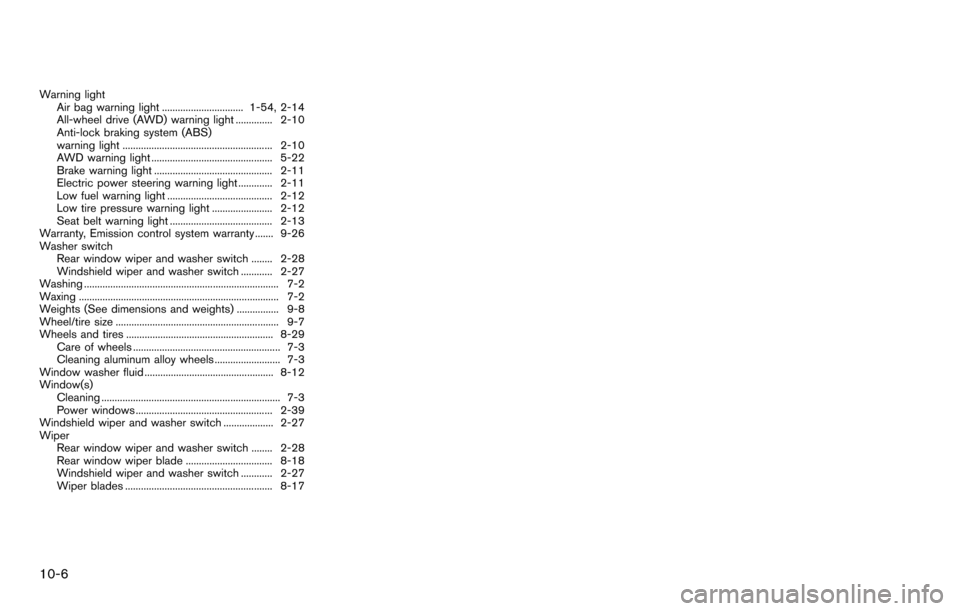
10-6
Warning lightAir bag warning light ............................... 1-54, 2-14
All-wheel drive (AWD) warning light .............. 2-10
Anti-lock braking system (ABS)
warning light ......................................................... 2-10
AWD warning light .............................................. 5-22
Brake warning light ............................................. 2-11
Electric power steering warning light ............. 2-11
Low fuel warning light ........................................ 2-12
Low tire pressure warning light ....................... 2-12
Seat belt warning light ....................................... 2-13
Warranty, Emission control system warranty ....... 9-26
Washer switch Rear window wiper and washer switch ........ 2-28
Windshield wiper and washer switch ............ 2-27
Washing .......................................................................... 7-2
Waxing ............................................................................ 7-2
Weights (See dimensions and weights) ................ 9-8
Wheel/tire size .............................................................. 9-7
Wheels and tires ........................................................ 8-29 Care of wheels ........................................................ 7-3
Cleaning aluminum alloy wheels ......................... 7-3
Window washer fluid ................................................. 8-12
Window(s) Cleaning .................................................................... 7-3
Power windows .................................................... 2-39
Windshield wiper and washer switch ................... 2-27
Wiper Rear window wiper and washer switch ........ 2-28
Rear window wiper blade ................................. 8-18
Windshield wiper and washer switch ............ 2-27
Wiper blades ........................................................ 8-17
Page 321 of 322
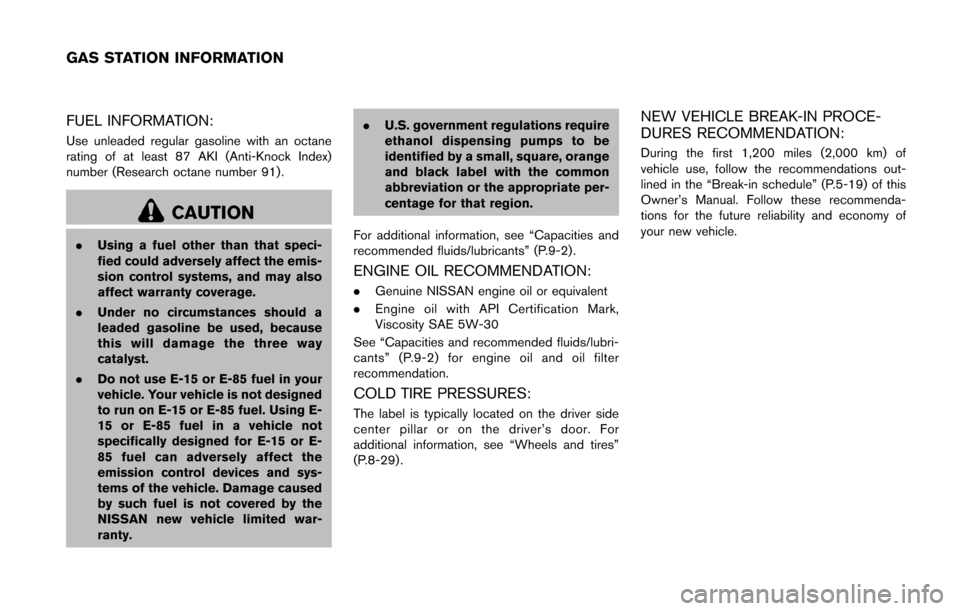
FUEL INFORMATION:
Use unleaded regular gasoline with an octane
rating of at least 87 AKI (Anti-Knock Index)
number (Research octane number 91) .
CAUTION
.Using a fuel other than that speci-
fied could adversely affect the emis-
sion control systems, and may also
affect warranty coverage.
. Under no circumstances should a
leaded gasoline be used, because
this will damage the three way
catalyst.
. Do not use E-15 or E-85 fuel in your
vehicle. Your vehicle is not designed
to run on E-15 or E-85 fuel. Using E-
15 or E-85 fuel in a vehicle not
specifically designed for E-15 or E-
85 fuel can adversely affect the
emission control devices and sys-
tems of the vehicle. Damage caused
by such fuel is not covered by the
NISSAN new vehicle limited war-
ranty. .
U.S. government regulations require
ethanol dispensing pumps to be
identified by a small, square, orange
and black label with the common
abbreviation or the appropriate per-
centage for that region.
For additional information, see “Capacities and
recommended fluids/lubricants” (P.9-2) .
ENGINE OIL RECOMMENDATION:
. Genuine NISSAN engine oil or equivalent
. Engine oil with API Certification Mark,
Viscosity SAE 5W-30
See “Capacities and recommended fluids/lubri-
cants” (P.9-2) for engine oil and oil filter
recommendation.
COLD TIRE PRESSURES:
The label is typically located on the driver side
center pillar or on the driver’s door. For
additional information, see “Wheels and tires”
(P.8-29) .
NEW VEHICLE BREAK-IN PROCE-
DURES RECOMMENDATION:
During the first 1,200 miles (2,000 km) of
vehicle use, follow the recommendations out-
lined in the “Break-in schedule” (P.5-19) of this
Owner’s Manual. Follow these recommenda-
tions for the future reliability and economy of
your new vehicle.
GAS STATION INFORMATION